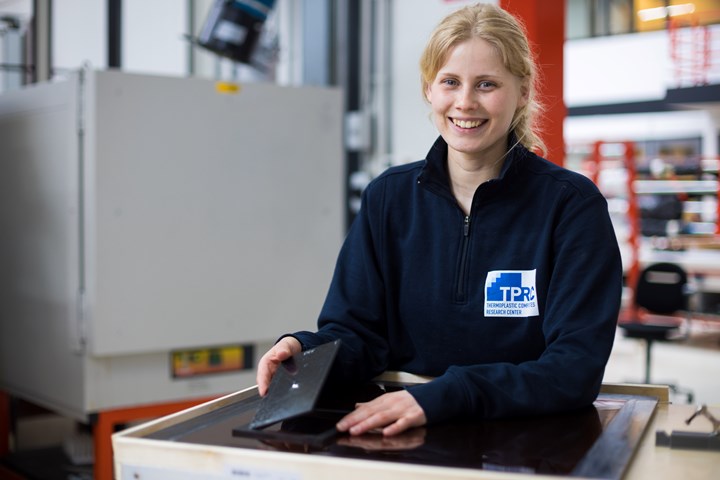TPRC research project investigates thermoplastic composite structure repair strategies
Linda Grafen’s two-year study explored reconsolidation and patch repair methods to determine their feasibility for impact damage repairing.
In collaboration with ThermoPlastic composites Research Center (TPRC, Enschede, Netherlands) industrial partners, Linda Grafen, lead development engineer at Bosch Thermotechniek B.V. (Deventer) and project engineer at TMC (Enschede), has finalized a two-year research project, “Fixing damages of thermoplastic composite structures (FICS),” performed within the Top Technology Twente – Connecting Industry program of the University of Twente (UT, Enschede). The objective of her work was to investigate thermoplastic composites repair strategies based on fusion bonding techniques, thereby exploiting the melt-processable nature of the thermoplastic matrix.
Grafen chose to focus on repairing impact damages, such as matrix transverse cracks and delaminations. During this project, she explored two different repair methods, namely reconsolidation and patch repair. She conducted a coupon-level study to understand the effect of these repair techniques on quality and mechanical performance of unidirectional (UD) carbon fiber-reinforced polyaryletherketone (C/PAEK) laminates.
The reconsolidation of impacted laminates was conducted using the vacuum-bag-only (VBO) method. Their mechanical performance was assessed via compression testing and compared to the compressive properties of impacted samples and an open-hole reference sample. It was found that the reconsolidation fully healed delaminations and matrix cracks, resulting in a recovery of the mechanical performance, as the samples outperformed the reference notched compressive strength.
The same VBO process was used to investigate the patch repair method. The mechanical performance of different patch configurations, such as scarf, step and scarf doubler, was evaluated via tensile testing and compared to the tensile properties of the reference material. Tensile properties comparable to the reference material were achieved, depending on the patch configuration.
Overall, this study demonstrates the potential of reconsolidation and patches as methods for repairing impact damages, ranging from barely visible to severe structural damages, and represents a way forward for developing melt-processable repair strategies for larger and complex thermoplastic composites structures.
Related Content
-
Plant tour: Collins Aerospace, Riverside, Calif., U.S. and Almere, Netherlands
Composite Tier 1’s long history, acquisition of stamped parts pioneer Dutch Thermoplastic Components, advances roadmap for growth in thermoplastic composite parts.
-
Bladder-assisted compression molding derivative produces complex, autoclave-quality automotive parts
HP Composites’ AirPower technology enables high-rate CFRP roof production with 50% energy savings for the Maserati MC20.
-
JEC World 2024 highlights: Thermoplastic composites, CMC and novel processes
CW senior technical editor Ginger Gardiner discusses some of the developments and demonstrators shown at the industry’s largest composites exhibition and conference.

















